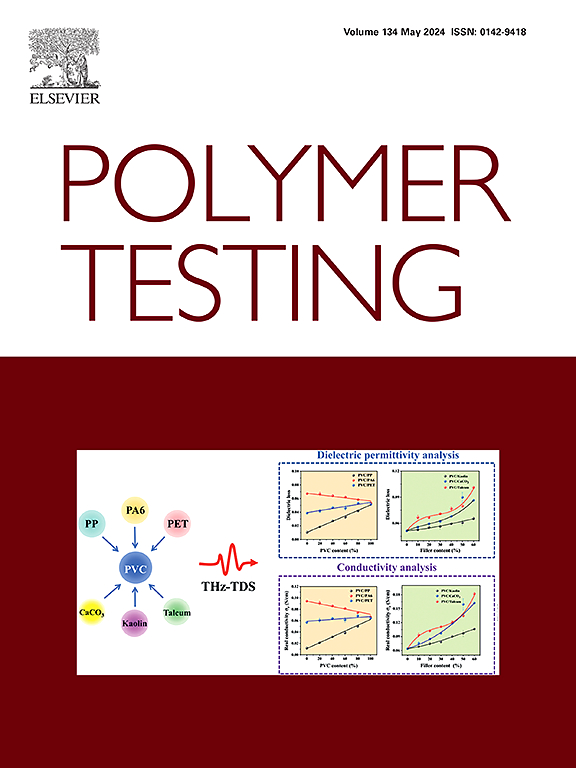串联电阻模型在预测涂布纸对氧和水蒸气渗透性中的适用性:数据质量和相关元数据的重要性
IF 6
2区 材料科学
Q1 MATERIALS SCIENCE, CHARACTERIZATION & TESTING
引用次数: 0
摘要
阻隔性能的预测在材料科学中是必不可少的,特别是在食品包装中,使用具有目标阻隔性能的包装材料是必不可少的。本研究评估了串联电阻模型的适用性,假设各层传递电阻的可加性,以预测聚合物涂布纸板的氧气和水蒸气渗透性。从文献中收集了35篇科学论文中250多条聚合物涂层纸板的渗透数据。然而,每篇文章所收集的渗透参数数据的质量不同,因此开发了一个质量指标来量化质量并评估其可重用性。在质量指标计算中使用了不同的标准,如准确性、完整性、一致性和可重用性。该质量指数强调,由于缺乏相关元数据,来自文献的大多数渗透参数数据(约58%)不可重复使用。尽管收集了大量的数据,但串联电阻模型只能适用于聚合物涂布纸板特殊情况下的少数渗透参数数据。虽然预测的渗透率值和实验的渗透率值(氧气和水蒸气)有时是一致的,但模型往往不能提供准确的预测。一个主要的假设是,这种模型没有考虑到材料中存在的浸渍层。虽然三层模型可能提供更准确的预测,但文献中缺乏关于浸渍层(厚度和渗透率)的定量信息,阻碍了它的使用和验证。本文章由计算机程序翻译,如有差异,请以英文原文为准。
Applicability of the series resistance model in predicting the permeability of coated papers to oxygen and water vapor: importance of data quality and associated metadata
The prediction of barrier properties is essential in materials sciences, especially in food packaging where the use of packaging materials with targeted barrier properties is essential. This study assessed the suitability of the series resistance model, assuming the additivity of transfer resistances of individual layers, to predict oxygen and water vapor permeabilities of polymer-coated cardboards. More than 250 permeation data of polymer-coated cardboards from 35 scientific articles were collected from the literature. However, the quality of collected permeation parameter data differed from one article to the other, therefore a quality index was developed to quantify the quality and assess their reusability. Different criteria were used in the quality index calculations such as accuracy, completeness, consistency, and reusability. This quality index highlighted that most permeation parameter data from the literature (∼58 %) were not reusable due to the lack of associated metadata. Despite the amount of data collected, the series resistance model could only be applied to a few permeation parameter data in the peculiar case of polymer-coated cardboards. While the predicted and experimental permeability values (oxygen and water vapor) sometimes aligned, the model often failed to provide accurate predictions. One major hypothesis being that such model did not consider the impregnated layer present in the materials. While a three-layer model might offer more accurate predictions, the lack of quantitative information in the literature regarding the impregnated layer (thickness and permeability) prevents its use and validation.
求助全文
通过发布文献求助,成功后即可免费获取论文全文。
去求助
来源期刊

Polymer Testing
工程技术-材料科学:表征与测试
CiteScore
10.70
自引率
5.90%
发文量
328
审稿时长
44 days
期刊介绍:
Polymer Testing focuses on the testing, analysis and characterization of polymer materials, including both synthetic and natural or biobased polymers. Novel testing methods and the testing of novel polymeric materials in bulk, solution and dispersion is covered. In addition, we welcome the submission of the testing of polymeric materials for a wide range of applications and industrial products as well as nanoscale characterization.
The scope includes but is not limited to the following main topics:
Novel testing methods and Chemical analysis
• mechanical, thermal, electrical, chemical, imaging, spectroscopy, scattering and rheology
Physical properties and behaviour of novel polymer systems
• nanoscale properties, morphology, transport properties
Degradation and recycling of polymeric materials when combined with novel testing or characterization methods
• degradation, biodegradation, ageing and fire retardancy
Modelling and Simulation work will be only considered when it is linked to new or previously published experimental results.
 求助内容:
求助内容: 应助结果提醒方式:
应助结果提醒方式:


